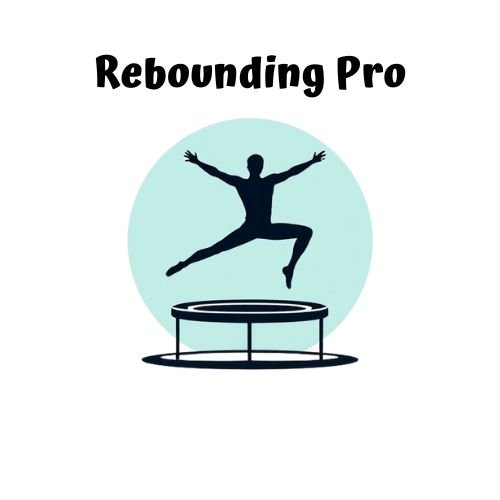High-intensity jumping on a rebounder burns massive calories because it achieves MET values up to 12.3—nearly 5 times higher than walking. You’ll torch 6.9-12.4 calories per minute while engaging your entire body simultaneously. The afterburn effect keeps your metabolism elevated for up to 24 hours post-workout, continuing to burn calories long after you’ve stopped exercising. Discover how a simple mini-trampoline can outperform traditional cardio for maximum fat-burning efficiency.
The Science Behind Rebounding’s Massive Calorie Burn

While many exercises promise effective calorie burning, rebounding stands out as a powerhouse for energy expenditure. When you bounce on a mini-trampoline, your heart rate elevates quickly, burning between 6.9 and 12.4 calories per minute depending on your intensity.
Rebounding supercharges your metabolism, burning up to 12.4 calories per minute while protecting your joints.
What makes rebounding so effective is its full-body engagement. Unlike walking or swimming, jumping activates multiple muscle groups simultaneously—legs, core, and upper body—increasing your metabolic rate considerably. Research shows that heavier individuals tend to burn significantly more calories during rebounding sessions, as demonstrated in the test where Alex burned nearly twice as many calories as Sydney.
For perspective, a 140lb person can torch approximately 405 calories in just 40 minutes.
The biomechanical efficiency of rebounding allows you to sustain higher-intensity workouts with less joint strain than running. This means you’ll burn calories more effectively while minimizing injury risk, making it suitable even if you have mobility concerns.
How MET Values Make Rebounder Exercises Calorie-Burning Powerhouses
You’ll burn more calories on a rebounder thanks to its impressive 7.2 MET value, which far outpaces walking’s 2.5 MET.
This high intensity rating translates directly to greater energy expenditure as your body works harder during each bounce. Using this MET value in the calorie burn formula, you can accurately calculate how many calories you’re burning during your rebounding sessions.
MET Maximizes Energy Expenditure
Understanding the concept of Metabolic Equivalent of Task (MET) reveals why rebounding exercises pack such a powerful calorie-burning punch. When you jump on a rebounder, you’re not just moving—you’re multiplying your body’s energy expenditure by 7-10 times your resting rate. For optimal health benefits, these vigorous-intensity activities align perfectly with recommended weekly exercise guidelines.
| Activity Type | MET Value | Calories/Hour (70kg) |
|---|---|---|
| Light Bouncing | 4-5 METs | 280-350 kcal |
| Standard Rebounding | 7-8 METs | 490-560 kcal |
| High-Intensity Jumps | 9-10 METs | 630-700 kcal |
| With Arm Movements | +1-2 METs | +70-140 kcal |
| Plyometric Jumps | 10+ METs | 700+ kcal |
Your body burns calories proportionally to MET level—doubling from 5 to 10 METs doesn’t just double calories, it creates compound effects through EPOC, extending burn long after you’ve finished jumping.
Rebounding Amplifies Caloric Burn
Rebounding exercises take the MET concept to remarkable heights, transforming simple jumping into a calorie-burning powerhouse. With an impressive MET value of 7.2, your rebounder workouts burn approximately 12.4 calories per minute—significantly higher than other low-impact activities.
You’ll engage multiple muscle groups simultaneously while your heart rate climbs, creating the perfect storm for caloric expenditure. The beauty lies in the customization: adjust your jumping intensity to match your fitness level while still achieving substantial results. The trampoline calculator provides a reliable way to estimate your calories burned accurately based on different activities.
Calculate your specific burn using the formula: MET (7.2) × 3.5 × your weight in kg ÷ 200. This gives you your per-minute caloric burn. Your weight directly influences this number, with heavier individuals burning more per session.
Despite being gentle on joints, rebounding delivers serious metabolic benefits alongside improved lymphatic drainage and balance.
Comparing Rebounding to Traditional Cardio: The Calorie Advantage

You’ll experience a significant metabolic boost with rebounding compared to many traditional cardio workouts, especially when performed at high intensity.
Unlike treadmills or stationary bikes that take up considerable space, a rebounder offers efficient calorie burning in a compact footprint that fits almost anywhere in your home.
Your body continues burning calories post-workout through the afterburn effect, making rebounding a time-efficient option when you can’t fit in longer cardio sessions. While rebounding burns approximately 250 to 400 calories per hour at a moderate pace, this can be increased by incorporating strength movements.
Metabolic Boost Comparison
When comparing high-intensity jumping exercises to traditional cardio workouts, the caloric advantage becomes immediately clear.
Jumping rope burns an impressive 15-20 calories per minute with a MET value ranging from 8.8 to 12.3, outperforming many conventional exercises.
At 100-120 skips per minute, you’ll achieve a MET of 11.8, translating to approximately 250-300 calories burned in just fifteen minutes.
While rebounding has a slightly lower MET than jumping rope, both activities engage multiple muscle groups simultaneously, maximizing energy expenditure.
The real metabolic magic happens after your workout ends. HIIT-style jumping workouts create an afterburn effect where your body continues to burn calories for up to 24 hours post-exercise.
Both jumping activities trigger elevated post-exercise oxygen consumption (EPOC), meaning your body continues burning additional calories for hours afterward.
This extended metabolic boost makes high-intensity jumping an efficient choice for your fitness goals.
Space-Efficient Calorie Burn
Beyond the metabolic advantages already discussed, the space efficiency of high-intensity jumping exercises offers a practical edge for fitness enthusiasts. You’ll burn comparable calories to running without needing a track, treadmill, or large space. Rebounding provides a full-body workout that effectively engages multiple muscle groups simultaneously.
| Activity | Calories/Hour | Joint Impact | Space Needed |
|---|---|---|---|
| Rebounding | 250-400 | Low | Minimal |
| High-Intensity Rebounding | Up to 876 | Low-Moderate | Minimal |
| Running | 300-600 | High | Extensive |
| HIIT Running | 600-900 | Very High | Moderate |
A 30-minute rebounding session burns approximately 234 calories while protecting your joints from the impact traditional cardio inflicts. You’ll experience significant heart rate elevation during high-intensity rebounding workouts, maximizing calorie burn without the joint strain that often accompanies running or jumping on hard surfaces.
Mini-Trampoline HIIT: Maximize Your Burn in Minimal Time
Mini-trampolines offer an extraordinarily efficient platform for High-Intensity Interval Training (HIIT), allowing you to maximize calorie burn in minimal time.
With potential to torch up to 12.4 calories per minute, you’ll outpace traditional exercises like walking or jogging in shorter sessions.
The formula is simple: alternate intense jumping bursts with brief recovery periods. You’ll not only create the calorie deficit needed for weight management but also boost your metabolism long after you’ve finished jumping.
Your fitness level determines intensity—start low and progressively increase as your endurance builds.
For maximum efficiency, incorporate varied jumping patterns and maintain proper form. High-quality rebounders create increased G-Force during workouts, significantly enhancing the effectiveness of your exercise routine.
The beauty of mini-trampoline HIIT lies in its adaptability; you’ll burn more calories at higher intensities while engaging multiple muscle groups simultaneously.
The Full-Body Engagement That Amplifies Rebounding Calorie Expenditure

The remarkable power of rebounding exercises stems from their ability to engage virtually every muscle group simultaneously, creating a calorie-burning symphony throughout your body.
As you bounce, your legs, calves, arms, and core all work in coordinated effort to maintain balance and rhythm, greatly increasing metabolic expenditure.
This full-body activation isn’t just burning more calories in the moment—it’s building strength and flexibility that enhances your overall fitness.
At higher intensities of 120-160 bounces per minute, you’ll reach MET values of 12.3, burning an impressive 15-20 calories per minute. The MET value indicates the significant energy expenditure required during high-intensity jumping compared to sedentary activities.
Your body weight, jumping speed, and technique further influence this calorie expenditure.
You’re effectively achieving the cardiovascular benefits of running or cycling, but with better coordination development and less space requirements.
Customizing Your Rebounder Workout for Optimal Fat Loss Results
Achieving ideal fat loss results with rebounding requires a strategic approach that extends beyond simply bouncing up and down.
To maximize calorie burn, adjust your workouts based on your specific needs and goals. Monitor your RPE during sessions, aiming for an 8+ during high-intensity intervals that can burn up to 87 calories in just 15 minutes.
Implement progressive overload by gradually increasing workout duration and intensity to prevent plateaus. Research shows that consistent rebounding practice can help burn an extra 820 calories in just 10 days. For enhanced results, incorporate strength training elements and HIIT sequences into your rebounding routine.
Don’t overlook lifestyle factors—maintain a calorie deficit through nutritional adjustments, prioritize sleep for recovery, and stay properly hydrated.
Track your progress using heart rate monitors and weight charts, making data-driven adjustments to your program as needed.
Frequently Asked Questions
Is Rebounding Safe for People With Joint Problems?
Rebounding can be safe for your joint problems since it’s low-impact—the trampoline absorbs most forces. You’ll need to maintain proper posture, use quality equipment, and get your doctor’s approval before starting this exercise.
How Many Calories Can a Beginner Expect to Burn?
As a beginner, you’ll likely burn 120-200 calories in a 10-minute jump rope session. Your weight, intensity, and technique affect this number. You’ll burn more as you build stamina and jump efficiency.
Can Rebounding Help Reduce Cellulite?
Yes, rebounding can help reduce cellulite by enhancing lymphatic drainage, toning muscles in cellulite-prone areas, reducing fluid retention, and improving circulation. You’ll see better results with consistent practice over several weeks.
Do Weighted Vests Increase Calorie Burn During Rebounding?
Yes, wearing a weighted vest while rebounding considerably increases your calorie burn. You’ll engage more muscles and create greater resistance, boosting energy expenditure by approximately 13% without adding high-impact stress on your joints.
How Often Should I Replace My Mini-Trampoline?
You should replace your mini-trampoline every 3-8 years, but inspect it regularly. Check elastic cords every 3-6 months and replace them every 2 years. Watch for mat tears, stretched springs, and rust on the frame.
In Summary
You’ve discovered rebounding’s secret power—high-intensity jumping creates a metabolic storm that torches calories efficiently. By leveraging high MET values through full-body engagement, you’re burning more than traditional cardio in less time. Your mini-trampoline HIIT workouts maximize calorie expenditure while being gentler on joints. Customize your rebounding routine to your fitness level, and you’ll transform these fun, bouncy sessions into your most effective fat-burning tool.





Leave a Reply